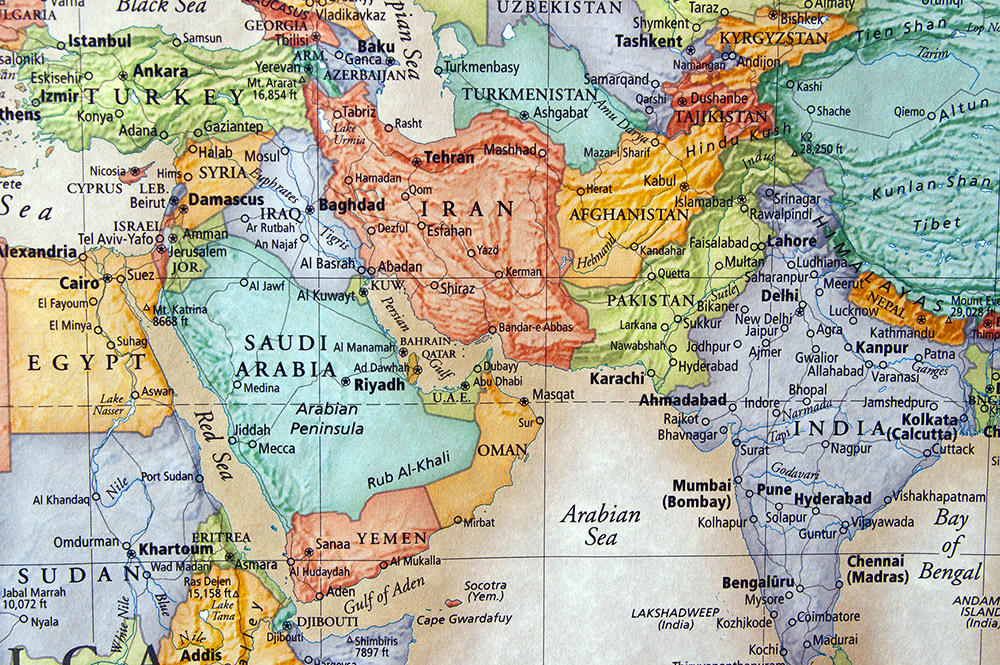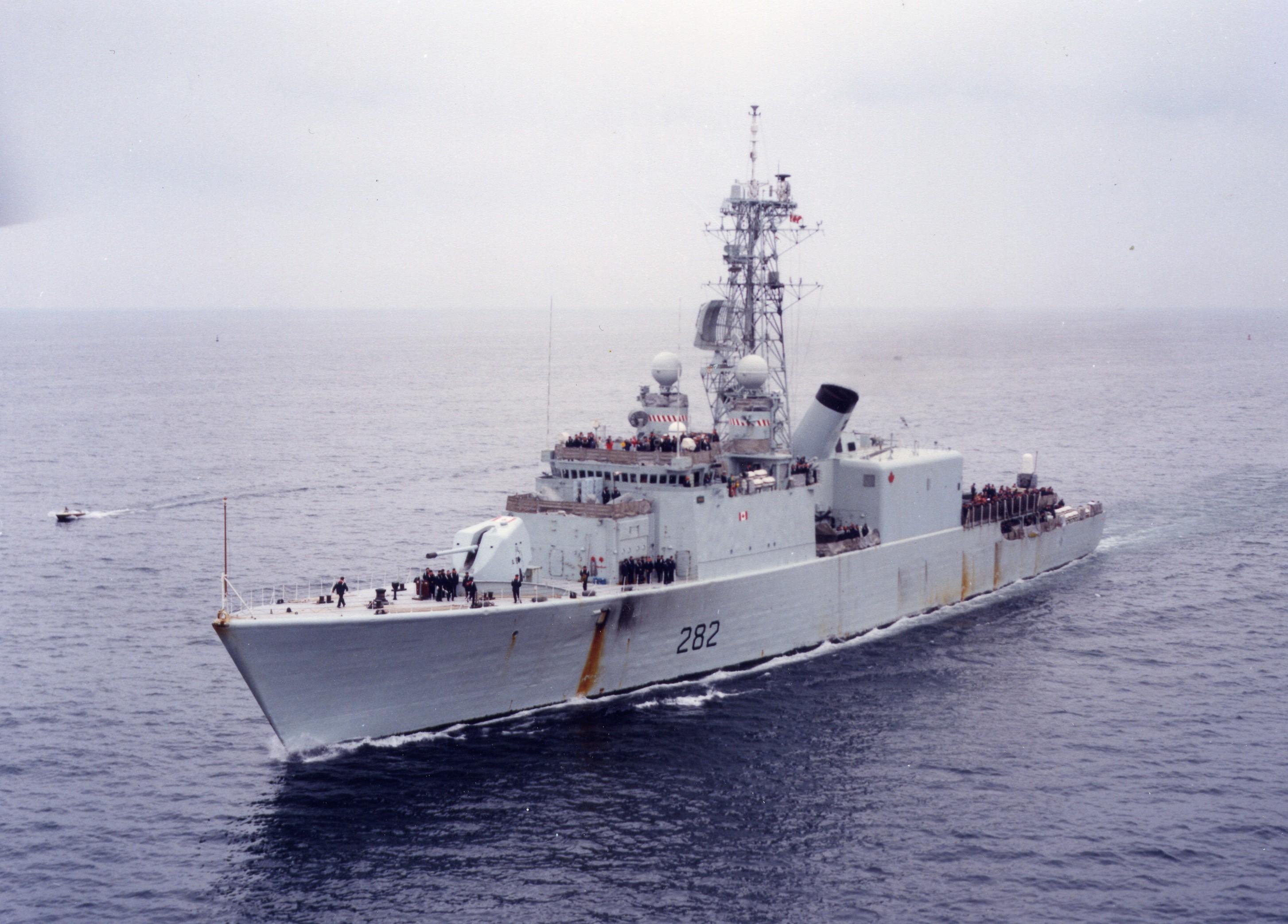From the Iraqi invasion of Kuwait in the summer of 1990 (see Persian Gulf War) until the withdrawal of forces from Afghanistan in 2014, the waters of South-West Asia were the operational focus of the Canadian navy. In that quarter-century, practically every major surface ship and the large majority of sailors deployed into the region at some point in their service. In many ways, it was the defining experience for a generation of Canadian sailors.

South-West Asia Theatre
The South-West Asia theatre of operations includes Afghanistan, the Persian Gulf, the Gulf of Oman, the Red Sea, the Suez Canal, and parts of the Indian Ocean and the Arabian Sea west of 68° E longitude and north of 5° S latitude.
The Persian Gulf War – Operation Friction
Before the summer of 1990, South-West Asia was not a typical theatre of operations for the Canadian navy. The first Royal Canadian Navy (RCN) vessels in the area were the cruisers HMC Ships Uganda and Ontario, which passed through the area in the last year of the Second World War, en route from Europe to operations in the Far East against Japan. Similarly, destroyers occasionally sailed through the area on their way to Japan and Korea during the Korean War. In 1956, the aircraft carrier HMCS Magnificent transported troops and equipment to Port Said at the Mediterranean mouth of the Suez Canal as part of Canada’s contribution to the United Nations Emergency Force I (UNEF I) but did not pass through into the Red Sea (see Suez Crisis). In the ensuing decades, no Canadian warships entered the region.
When Saddam Hussein invaded Kuwait in early August 1990, the general presumption was that Canadian participation would be limited to a peacekeeping contingent after hostilities had ended. When the UN Security Council imposed sanctions against Iraq, however, Prime Minister Brian Mulroney ordered the Canadian navy to dispatch a naval task group to join the Multinational Interception Force (MIF) embargo, under the codename Operation Desert Shield (styled in Canada as Operation Friction). The aging destroyers Athabaskan and Terra Nova and the supply ship Protecteur were hastily upgraded with new weapon and command and control systems obtained from the Halifax-class Canadian Patrol Frigate program and the Iroquois-class Tribal Update and Modernization Program (TRUMP) project. Soon after taking up station in the Central Persian Gulf in early-October, they were joined by an air task group of CF-18 Hornet fighter jets. The coalition naval forces were coordinated by the US Navy (USN).
The emphasis on sanction enforcement allowed the Mulroney government to maintain that the Canadian navy was operating under UN auspices rather than those of the American invasion forces. During the war phase of Operation Desert Storm, the USN delegated Canadian task group commander Captain (later Vice Admiral) Duncan “Dusty” Miller with tactical control of the naval forces from other coalition partners who wished to remain separate from the offensive action ashore. This was the only independent warfare commander role assigned to a non-USN officer during the operation. (See Persian Gulf War, 1990-91)

United Nations Sanctions Against Iraq in the 1990s
One of the ceasefire conditions of March 1991 imposed on Iraq was formalization of the MIF mandate to maintain the embargo under United Nations Security Council Resolution (UNSCR) 687. The Canadian government wanted to remain involved in the effort, but the state of the fleet limited participation, as the navy was transitioning to new frigates. Thus, the Canadian navy sent single ships to the northern Persian Gulf and the Red Sea until the summer of 1992.
In the mid-1990s, the fleet received the new Halifax-class frigates, which allowed renewed deployments to the region. In 1995, HMCS Fredericton was sent to the region under Operation Promenade intended to help promote Canadian technology and trade at various locations in the Gulf States. Later that year, Canada rejoined the MIF after a three-year absence, as much to showcase the new high-tech frigate as to support the embargo. However, with the ongoing transition of the fleet, it would be two years before another frigate could participate.
The continuing non-compliance of Saddam Hussein with UN inspection requirements led to a flurry of UNSCRs in 1997–2001, and with them a more forceful and sustained Canadian presence. Beginning with Operation Mercator (August to October 1998), Canadian ships were fully integrated into USN carrier battle groups, replacing American warships one-for-one in the order of battle. Hussein’s intransigence towards the UN increased such that HMCS Winnipeg (the last frigate so deployed) performed several “non-compliant” boardings through the spring and summer of 2001.

Post 9/11 – Operation Apollo
It was in this context that the 9/11 terror attacks occurred. Canadian warships from both coasts were the first formed military units to deploy in support of the US Operation Enduring Freedom (Canadian codename Operation Apollo). Canada’s decision to participate was informed by NATO Article 5, which states that if a member of NATO is attacked, it is considered an attack against all members, who will assist their ally as necessary. As it became clear that American offensive action would be focussed on Afghanistan, the frigate HMCS Halifax (then in European waters with NATO’s Standing Naval Force Atlantic) was redirected on 8 October to join the USN forces gathering in the Arabian Sea. The frigate Vancouver, which had been preparing to sail from Esquimalt, British Columbia, for the regular sanctions-enforcement regime, sailed as intended at the end of the month.
Meanwhile, on 17 October, a full task group sailed from Halifax under the command of then-Commodore Drew Robertson (a future Commander of the Navy). When the task force arrived off the southern coast of Pakistan on 26 November, Robertson was assigned responsibility for the defence of the USN Amphibious Ready Group from which the US Marine Corps (USMC) expeditionary airborne assault on Afghanistan was being executed. He was also provided additional USN destroyers for the purpose, a rare sign of trust due entirely to the close interoperability of the Canadian and US naval forces. By January 2002, there were six Canadian warships in the region, one-third of the RCN’s entire surface fleet.

As USMC operations in Afghanistan wound down, naval forces became involved in the search for Al-Qaeda and Taliban terrorists attempting to escape by sea from Pakistan and Iran to the Horn of Africa by crossing the Gulf of Oman in local small vessels known as “dhows.” By this time, other coalition forces were arriving, and because of the Canadians’ familiarity with the area and type of operation, Robertson’s command was adapted to oversee the multinational formation. This became the focus of the Canadian naval effort for the next year and a half (December 2001 to March 2003), with a succession of task groups from both the west and east coast fleets rotating into theatre to maintain a steady Canadian presence. In total, Canadian warships undertook 600 boardings of suspicious vessels (50% of the coalition total) resulting in the detention of several high-profile terrorist figures and the effective closure of this escape route.

The third phase of naval operations began with the buildup of coalition forces for Operation Iraqi Freedom. Canada and many other coalition nations did not support that expansion of the war but recognized that the stream of international shipping through the Strait of Hormuz would be an attractive target for terrorists. The Canadian commodore, now with the title of “Commander Task Force 151” (CTF 151), organized hundreds of close escorts by coalition forces through the Strait. As ground operations in Iraq stabilized through the summer of 2003, this effort tapered off and coalition forces (including Canada’s) wound down operations. The last Canadian warship, the frigate Calgary, departed the Arabian Sea without replacement on 1 November 2003, having conducted 24 boardings and 92 transits of the Strait, all uneventful.

Operation Apollo: Significance
Although the Canadian naval contribution to post-9/11 operations in South-West Asia is often forgotten, Operation Apollo was the Canadian navy’s largest sustained effort since the Korean War. Nearly the entire major surface fleet was deployed: 16 of 17 destroyers and frigates, both supply ships, and over 4,000 sailors, some 95% of the available sea-going personnel. (The only frigate that did not participate, Ville de Quebec, was in the region, but supporting World Food Organization relief efforts into Somalia.) Moreover, the role as CTF 151 remains the only operational-level command exercised by a senior Canadian officer of any branch of the forces in an active theatre since the Second World War.
Operations Altair, Saiph & Artemis
Between 2004 and 2008 (Operation Altair), Canadian naval support in the theatre involved the irregular deployment of a frigate to maintain an at-sea counter-terrorism presence during military operations in Afghanistan. The high point of this effort was in the summer of 2008, when Commodore (later Vice Admiral) Bob Davidson was assigned command of the coalition forces, now reorganized as CTF 150, from his flagship destroyer Iroquois, supported by the frigate Calgary and supply ship Protecteur.
Canada continued to send ships to the region under Operation Saiph (a direct NATO counter-piracy operation, 2009-12) and Operation Artemis (2012-present). It has also led CTF 150 on several occasions since 2012 in the Central Command Headquarters ashore in Bahrain. Most recently, Captain Colin Matthews took command of CTF 150 on 17 January 2024.
Did you know?
The Canadian frigate HMCS Regina was serving in CTF 150 in April 2014, when it was hastily reassigned to support Operation Reassurance in European waters following Russia’s invasion of Crimea.

 Share on Facebook
Share on Facebook Share on X
Share on X Share by Email
Share by Email Share on Google Classroom
Share on Google Classroom




